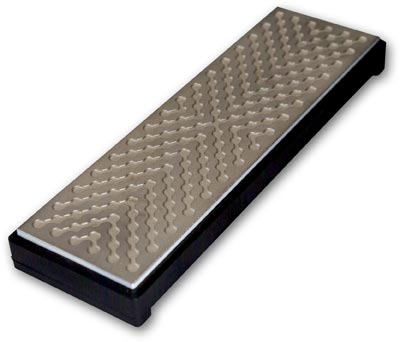Before we start honing, the honing stones must be flattened in a process called lapping. Lapping accomplishes three things: 1) flattens the honing stone, 2) smooths the surface, and 3) cleans the hone. It doesn’t matter whether the stone is natural, ceramic, diamond based, or synthetic; the hone must be lapped. We flatten our hones using a lapping plate rated at .001″ flatness over the entire length. This produces a perfectly flat honing surface.
Failing to lap the stones before each use can result in micro-chipping from surface imperfections, destroying the edge. If the stone isn’t lapped, the stone won’t be flat either, creating peaks and valleys in the surface of the stone. A perfectly flat stone imparts a perfectly flat edge. The second reason we lap our stones after each session is that lapping cleans the stones. A dirty hone is not nearly as effective as a clean hone and trapped steel particles can damage the edge we’re trying to create. It should also be noted that the lapping medium will confer to the hone the qualities of the lapping plate. For example, if you lap using a 100 grit stone, the hone will end up being very scratched and have surface characteristics of the 100 grit stone. Thus, it is important to lap extremely high grit stones with equally high grit diamond stones/sandpaper.
We have no connection with Shapton, but the lapping plate they produce is quite possibly the finest on the market. We like using it and highly recommend it. You can buy a Shapton DGLP here.




